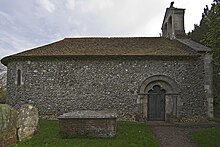
Guy Carleton, 1st Baron Dorchester, known between 1776 and 1786 as Sir Guy Carleton, was a British Army officer and colonial administrator. He twice served as Governor of the Province of Quebec, from 1768 to 1778, concurrently serving as Governor General of British North America in that time, and again from 1785 to 1795. The title Baron Dorchester was created on 21 August 1786.
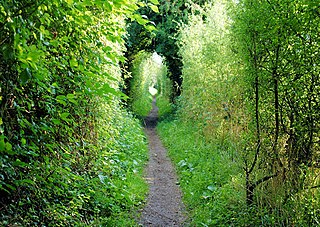
St Swithun's Way is a 34-mile (55 km) long-distance footpath in England from Winchester Cathedral, Hampshire to Farnham, Surrey. It is named after Swithun, a 9th-century Bishop of Winchester, and roughly follows the Winchester to Farnham stretch of the Pilgrims' Way. The route was opened in 2002 to mark the Golden Jubilee of Elizabeth II.

Bintree is a village and civil parish in the English county of Norfolk.

St Martha's Hill is a landmark in St Martha in Surrey, England between the town of Guildford and village of Chilworth. It is the 18th highest hill in the county and on the Greensand Ridge, in this case at the closest point to the North Downs, commencing to the immediate north at the Guildown-Merrow Down in the parishes of Guildford and Merrow. The top of the hill provides a semi-panorama of Newland's Corner also in the Surrey Hills AONB. Its church is the main amenity of the small parish extending to the south into the streets of Chilworth, with some medieval stone incorporations from a 12th-century predecessor and is a wedding venue mainly to outside the sparsely populated parish.
General Thomas Carleton was an Irish-born British Army officer who was promoted to colonel during the American Revolutionary War after relieving the siege of Quebec in 1776. After the war, he was appointed as Lieutenant-Governor of New Brunswick, and supervised the resettlement of Loyalists from the United States in the province. He held this position until his death, although he was absent in England for the last fourteen years of his tenure, refusing orders to return in a dispute about seniority.
Greywell is a small village and civil parish in Hampshire, England – a past winner of the Best Kept Village in Hampshire competition and a recent winner of Best Small Village in Hampshire. It lies on the west bank of the River Whitewater, 6 miles east of Basingstoke and 1.5 miles west of Odiham. The area is popular with walkers and cyclists. Many photographers also take pictures of some of the local architecture. There are 29 Grade II listed buildings or entries in the area, and 2 Grade II* listed buildings. The nearby medieval Odiham Castle is of historical interest. At the centre of the village is the Fox and Goose public house.

The Church of St Andrew, Holborn, is a Church of England church on the northwestern edge of the City of London, on Holborn within the Ward of Farringdon Without.

St Christopher le Stocks was a parish church on the north side of Threadneedle Street in the Broad Street Ward of the City of London. Of Medieval origin, it was rebuilt following the Great Fire of London in 1666, but demolished in 1781 to make way for an extension of the neighbouring Bank of England.
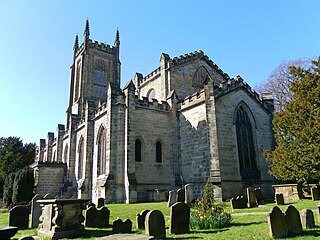
St. Swithun's is a Church of England church in East Grinstead, West Sussex, England, which is a Grade II* listed building.

Much Birch is a village and civil parish in Herefordshire, England, between Hereford and Ross-on-Wye. The parish includes the settlements of Kings Thorn, Much Birch and parts of Wormelow.

St Swithun's Church, Thorley is a parish church in the Church of England located in Thorley, Isle of Wight.
St Swithun's Church, named after St Swithun who was an Anglo-Saxon bishop of Winchester, can refer to numerous churches:

Up Nately is a small village and former civil parish, now in the parish of Mapledurwell and Up Nately, in the Basingstoke and Deane district, in Hampshire, England, located five miles to the south east of Basingstoke.
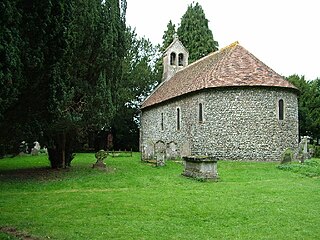
Nately Scures is a small village and former civil parish, now in the parish of Newnham, in the Basingstoke and Deane district of Hampshire, England. Its nearest large village is Hook, which lies approximately 1.7 miles (2.7 km) north-east from the village. In 1931 the parish had a population of 288.

St Lawrence Church is a parish church in the Church of England in Winchester.
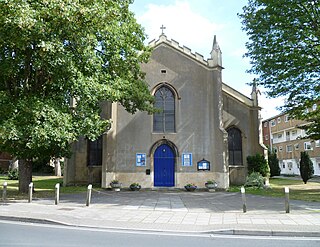
St Mary de Lode Church is a Church of England church immediately outside the grounds of Gloucester Cathedral. It is believed by some to be on the site of the first Christian church in Britain. The church is in the Diocese of Gloucester and Grade I listed by English Heritage. It has also been known as St. Mary Before the Gate of St. Peter, St. Mary Broad Gate and St. Mary De Port.
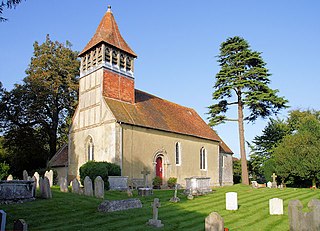
St Swithun's Church, Martyr Worthy is a Church of England parish church in Martyr Worthy, Hampshire, England.

St Swithun's Church is a Grade II* listed Church of England parish in the Diocese of Southwell and Nottingham in East Retford, Nottinghamshire, England.

The Church of St Mary and St Thomas is one of two Anglican churches in Knebworth, Hertfordshire, England. The church dates from the twelfth century and is a grade I listed building.
St Margaret was a parish in the ancient borough of Southwark, located south of the River Thames in the Brixton Hundred of Surrey. It was abolished in 1541 during the Dissolution of the Monasteries and replaced with the parish of St Saviour. The parish church was located on what is now Borough High Street and the area now forms part of the London Borough of Southwark. It was from 1444 governed by the Guild of the Assumption of St Margaret's Church.
